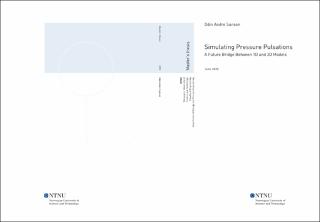| dc.contributor.advisor | Storli, Pål-Tore Selbo | |
| dc.contributor.advisor | Faudot, Celine | |
| dc.contributor.author | Sanson, Odin Andre | |
| dc.date.accessioned | 2021-09-20T16:45:51Z | |
| dc.date.available | 2021-09-20T16:45:51Z | |
| dc.date.issued | 2020 | |
| dc.identifier | no.ntnu:inspera:57317709:34483063 | |
| dc.identifier.uri | https://hdl.handle.net/11250/2779609 | |
| dc.description.abstract | Utmattelsesbelastning er den primære årsaken til turbinskade i vannkraftverk. Syklisk belastning fra trykkpulsasjoner kan forårsake slik utmattelsesbelastning. Tilegning av informasjon om trykkpulsasjoner, og samspillet mellom turbin og vannvei, kan bidra til å unngå tidlig svikt i turbinene. Fenomenet kan studeres gjennom feltmålinger, men å utføre og vurdere målinger for vannkraftstasjon er utfordrende, og i enkelte tilfeller umulig. Følgelig kan simuleringsverktøy benyttes for å undersøke fluidtransienters oppførsel. Et forlokkende alternativ er å kombinere en effektiv endimensjonal (1D) modell med tredimensjonal (3D) numeriske strømningsberegninger (CFD) i en koblet simulering. Foreløpig er dokumentasjonen på 1D-3D-koblede modeller et mangelfullt område. Fokuset til denne oppgaven er 1D modellen, og å undersøke hvordan en 1D-3D-koblet modell kan realiseres.
Karakteristikkmetoden (MOC) ble benyttet som 1D modell. Den ble kodet i MATLAB, og tre forskjellige friksjonsmodeller anvendt. Modellene ble validert med resultater fra litteraturen. Simuleringene viser at transient friksjon må benyttes i simulering av et trykkstøt i et tynt rør med laminær strøm. Videre viser en nyere studie at valget av friksjonsmodell er avhengig av størrelsen, og Reynolds tallet, til systemet.
For å løse problemet med overføring av data mellom 1D- og 3D-modellen ble en 2D-hastighetsprofil generert ved å bruke trykkgradienten fra 1D MOC som kildetermen i varmeligningen. Formen og oppførselen til hastighetsprofilene virket tilfredsstillende, men den nye hastighetsprofilen bevarte ikke volumstrømmen. Denne feilen er sannsynligvis relatert til den beregnede viskositeten, eller at den numeriske løsningen ikke er i stand til å følge de plutselige og store endringene relatert til et trykkstøt.
En lovende metode, er en delvis overlappede koblings-teknikk (POC) for å overføre data mellom 1D MOC og 3D CFD. På grunn av tidsbegrensninger, er anvendelsen av denne metoden utenfor omfanget av denne oppgaven.
Den generelle oppfatningen er at det mangler eksperimentelle data og dokumentasjon på dette feltet. Veien videre i studiet av 1D-3D-koblede modeller, bør inneholde relevante eksperimenter. | |
| dc.description.abstract | Fatigue loads are the primary cause of turbine failure in hydro power machinery. Cyclic loads from pressure pulsations can cause such fatigue loads. Gaining information on pressure pulsations, and the interaction between the turbine and the waterways, could be used to avoid premature failure of the turbines. The phenomenon could be studied through field measurements. However, performing and assessing measurements for a hydro power station is challenging, or can even be impossible. Accordingly, simulation tools could be utilized to gain knowledge on the behaviour of the fluid transients. A compelling option is to combine an efficient one-dimensional (1D) model with three-dimensional (3D) computational fluid dynamics (CFD) for a coupled simulation. Currently, the documentation on 1D-3D coupled models is a lacking field. The scope of this thesis the 1D model, and to investigate how a 1D-3D coupled model can be realized.
The method of characteristics (MOC) was investigated as the 1D model. MATLAB was used to code the MOC, and three different friction models were applied. Results from the literature were used to validate the models. The simulations show that transient friction must be accounted for when simulating a water hammer event in a thin pipe with a flow of a low Reynold's number. Furthermore, a newer study shows that the choice of friction model is dependent on the size and Reynold's number of the system.
To solve the problem of transferring data between the 1D and the 3D model, a 2D velocity profile was generated using the pressure gradient from the 1D MOC as the source term in the heat equation. The shape and behaviour of the velocity profiles seemed satisfactory, however, the new velocity profile did not conserve the flow rate. This error is likely related to the computed viscosity, or that the numerical solver is unable to accurately capture the sudden and large changes related to a water hammer event.
A promising method is the partly overlapped coupling (POC) technique, a non-iterative way of transferring data between the 1D MOC and 3D CFD. Due to time limitations, application of this method is outside the scope of this thesis.
The overall perception is that there is a lack of experimental data and documentation in this field. In order to further investigate 1D-3D coupled models, relevant experiments should be conducted. | |
| dc.language | | |
| dc.publisher | NTNU | |
| dc.title | Simulation of Pressure Pulsations | |
| dc.type | Master thesis | |
